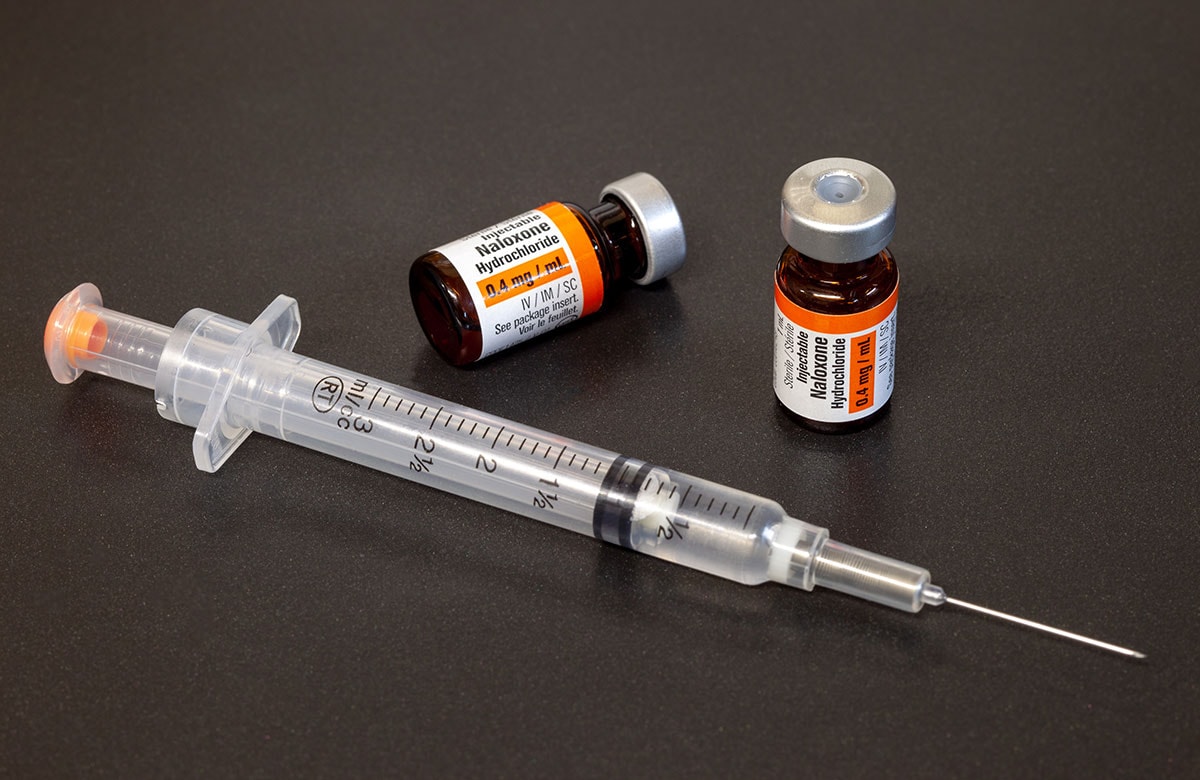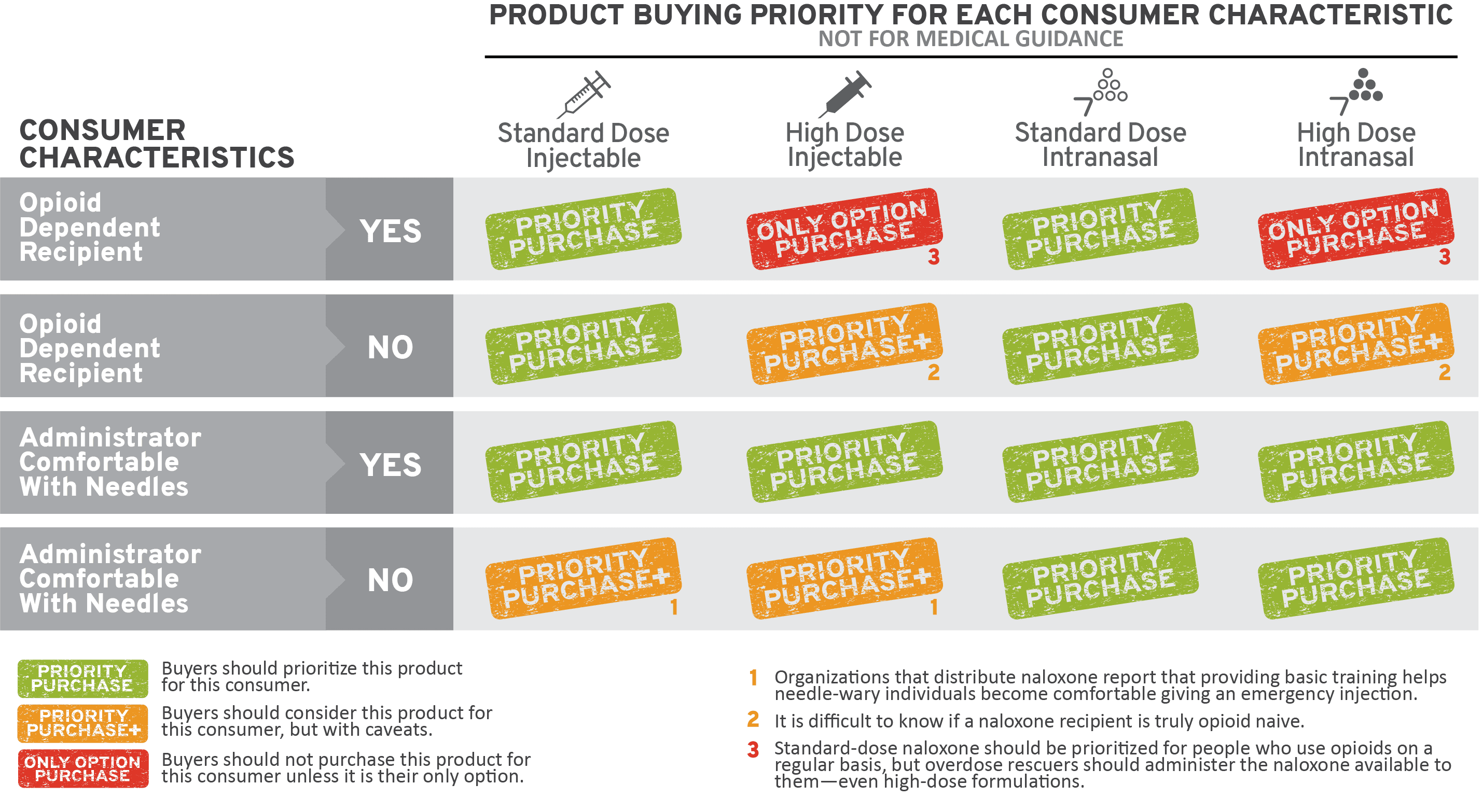Optimizing Consumer Choice for Overdose Reversal Medications
In recent years, in response to the persistent overdose crisis in the United States, the U.S. Food and Drug Administration (FDA) has approved two opioid overdose reversal medications—naloxone and nalmefene—in a number of formulations both for prescription and over-the-counter sale. Because experts generally agree that nalmefene offers no benefit and a considerable risk of harm compared to naloxone, we will focus on factors affecting consumer choice among various naloxone products.
Naloxone comes in a variety of doses—typically classified as “standard” or “high” dose—and can be administered via injection or as a nasal spray. Although all of these products have been shown to reverse an opioid overdose effectively, their utility and potential unintended consequences vary depending on who is receiving or administering them. Therefore, different groups disagree about which products should be prioritized, especially in policy and group purchasing efforts. Traditional harm reduction organizations generally call for continued use of standard-dose naloxone, and many still prefer injectable products. However, some harm reduction organizations have seen a growing preference for intranasal naloxone formulations among their participants. Furthermore, some families and community organizations—especially those that do not usually serve people who are opioid dependent or do not know they are serving people who are opioid dependent—report preferring the higher-dose naloxone options now available.
“Consumer choice” is a concept that, at the most basic level, elucidates how individuals decide which products to purchase. Therefore, it can help purchasers decide how to wield their budgets most effectively to reduce overdose deaths through the purchase and distribution of overdose reversal medications. But what does consumer choice even mean when applied to a life-saving drug like naloxone?

Identifying the Right Naloxone Product(s) for Consumers
Naloxone is an effective medication that can reverse an opioid overdose and restore breathing within minutes if administered in a timely manner. However, with multiple products on the market, it can be challenging for grassroots organizations, government agencies, and policymakers to know which to prioritize and supply to consumers.
First, we must consider the question of “preference” in an increasingly complex context that includes:
- an ever-changing illicit drug supply contaminated with established and novel adulterants;
- the continued emergence and FDA approval of new overdose reversal products; and
- the dynamic drug use behaviors of individuals.
In addition, because actual purchasing of overdose reversal medications often happens in bulk and at the organization or government level, purchasers may need to consider budgets and the individual product preferences of the potential consumer groups they serve. To do this, they must ask:
- Who are we purchasing for?
- What are the factors that shape the final consumers’ (recipients and administrators) preferences and needs?
Thus, to optimize efforts to make overdose reversal medications accessible at the community level, lawmakers, health agencies, and service providers must consider their local drug market, who their consumer is, and how they are likely to access the medication. The following discussion can help naloxone purchasers and distributors understand how to use consumer choice to benefit the people they serve.
Understanding the Consumer
Although organizations and government agencies may do the purchasing, the final consumer for each dose of naloxone bought and distributed consists of two individuals: the person receiving the medication (the person at risk for overdose) and the person administering it (often, a person who uses drugs and/or is a friend or family member of the person at risk for overdose). Therefore, bulk purchasers must consider the needs and preferences of the person who will receive the medication and the person who will administer it.
The Consumer as the Person Receiving Naloxone
The needs of the person receiving naloxone are rooted in the specifics of their overdose risk and how those elements shape the most appropriate dose of the medication. In order to understand this, it is important to ask whether the individual is likely to be opioid dependent or if perhaps they are opioid naive.
Individuals who have developed a high tolerance for and dependence on opioids are likely to respond very well to standard doses of naloxone and more likely to experience “precipitated withdrawal” if a high dose is administered. These withdrawals can cause tremors, muscle aches, diarrhea, vomiting, and more. For vulnerable individuals who are not medically managed, withdrawals can become directly life threatening. But even less severe withdrawals can cause harm beyond extreme discomfort. In the short term, they drive people to seek out and use more opioids to stop the symptoms, which may lead to a relapse into overdose. In the longer term, naloxone-precipitated withdrawal can undermine trust in medical systems, harm reduction organizations, and even their social networks—all factors that increase their risk of using alone in the future.
People who are opioid naive or who do not have any opioid dependence risk overdosing on much lower doses of opioids but should not experience withdrawals when naloxone is administered. Therefore, while it is not clear that higher doses of naloxone are needed to reverse overdoses in these individuals, they are much less likely to be harmed by the higher-dose naloxone products.
To help identify whether the person at risk of an overdose could be opioid dependent, it is helpful to understand the individual’s typical drug use patterns and how those intersect with the local illicit market.
- Does the person intentionally use opioids on a regular basis, either alone or with other drugs? (Note that some prescription painkillers like Percocet contain opioids.)
- Does the person primarily or exclusively use stimulant drugs, psychedelics/party drugs, or other non-opioids?
- Are local stimulant or other drug supplies in the area consistently adulterated with opioids such that the individual may regularly use opioids unintentionally?
The Consumer as the Person Administering Naloxone
A person who is overdosing on opioids experiences severe respiratory depression—meaning they are unconscious, not breathing, and must rely on others to give them the lifesaving medication. The people who are most likely to be present at an overdose and thus to administer naloxone are other people who use drugs, as well as friends or family members of the person who is overdosing. Others who may find themselves reversing an opioid overdose include first responders—both law enforcement, who typically have minimal medical training, and emergency medical responders like firefighters or paramedics—as well as bystanders who do not know the overdose victim.
As with the individual who is overdosing, those who may find themselves administering naloxone are not all the same and may therefore have varying needs and preferences when it comes to overdose reversal products.
One of the most important factors to consider for people who will be administering naloxone is their comfort level with the two administration methods: injection and nasal spray. People who use drugs, especially individuals with experience injecting drugs, as well as people with medical training, are often comfortable injecting naloxone into the muscle. This route of administration is very effective and has some benefits; the dose can be titrated to balance reversal efficacy and minimize withdrawal risk, and the product is inexpensive relative to intranasal formulations.
However, not everybody who finds themselves in a position to reverse an overdose is comfortable with needles. As such, nasal spray devices provide an important alternative option. Designed and packaged for single use, intranasal products are easy to use with minimal training and require no additional steps (such as pulling the medication into a syringe) beyond opening the package. Furthermore, some of these products are available over the counter, making them readily accessible for individuals who can afford it.
Regardless of which products are provided to consumers, distributing organizations should continue providing education regarding the provision of supportive care, including rescue breathing.
(The following graphic provides some guidelines to help bulk purchasers identify which products might be most suitable for their specific consumer audiences. These recommendations are intended to help purchasers and distributors prioritize certain products—not for medical guidance. Witnesses to an overdose should administer whatever naloxone formulation they have available according to product instructions, engage in rescue breathing, and call 911 for follow-up medical support.)

What This Means for Policymakers
Due to the variety of factors that can affect which naloxone formulation(s) make the most sense for which people, lawmakers should prioritize flexibility while government agencies take steps to minimize access barriers for those individuals who are most economically and geographically vulnerable. In practice, this means that legislative language allowing the possession and distribution of overdose reversal medications and offering protections for their distribution and administration should be broad and allow for rapid adaptation as new products become available. Furthermore, overdoses are becoming only more complex with increased market adulteration and rising polydrug use. As such, lawmakers should continue to evaluate and improve upon their Good Samaritan Laws, which protect laypeople responding to overdose and provide liability protections for people distributing naloxone.
However, government agencies and other bulk purchasers, such as harm reduction coalitions, will likely want to target their use of funds. For example, harm reduction organizations may need to tap into opioid settlement funding to get sufficient amounts of the appropriate consumer formulations for their clients. On the other hand, state budgets may need to provide for a broader array of consumer groups and provide differing options. In either case, considering the preferences and needs of consumers within the local context is essential, and purchasers must remain flexible enough to adapt to their participants’ changing needs.